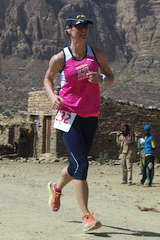Welcoming Mistina Sayani to Peaceful Dumpling! Based in beautiful Calgary, Canada, Mistina is the founder of Spotted Bean Food Coaching, a vegan ultra runner, world traveler, soon-to-be certified Holistic Nutritionist, and lover of the outdoors. We’re so happy to have her on board and looking forward to many more posts on her world travels, vegan fitness, and more!
____
Ethiopia is a land that conjures up many images: Dusty landscapes, poverty, World Aid, aging news reels of war and famine and strife. When we think of Ethiopia we almost never think about cuisine, complex flavors, rich dishes served communally on large flat breads called injera. Eaten with nature’s utensils, among friends and family. We never imagine these things but yet that is the reality of Ethiopia today.
I had the absolute pleasure this year of spending two weeks in Northern Ethiopia, working, volunteering and running. When I first signed up for this trip I had no idea what to expect; and like most vegans who plan on traveling to the unknown, after the initial excitement about going to Africa settled down, the mental calculation of how many Vega bars I would need to sustain myself for 14 days began. What sort of fruit would be available on the other side of the world? Could I fit all those bars in my suitcase, and still have room for my underwear? Would my hypothesis–that everywhere you go, no matter how remote, how impoverished, how off the beaten track, there will always be French fries—hold true?
Steadfast with my faith in the prevalence of the almighty potato, a loaf of frozen banana bread and an army of Vega bars I boarded the plane and set off into the African continent.
Ethiopian cuisine, like Ethiopians themselves, is a delightful fusion between East Africa and the Middle East. At its heart is a form of flat bread known as injera. If San Francisco sour dough and the English crumpet mated, injera would be their unlikely offspring. Light and spongy, it is comprised of teff flour, each baker’s secret starter and water, then left to ferment for 3-5 days. From the earthen hearths of Ethiopia’s 80% rural population to the five star hotels in Addis Ababa, all kitchens great and small have a dedicated griddles specifically for this staple bread.

Making injera, country style. Hardened mud and clay stove complete with cow dung fueled fire included.
For vegans Ethiopia is a breath of fresh air. During religious fasting times the consumption of animal products is prohibited and due to the arid landscape, a large variety of vegetable based “wots” or curries, fill every menu. With a somewhat bruised ego buffered only by the overwhelming number of other more delicious choices I must concede my French fry hypothesis to be debunked. From the spicy to the mild, aromatic and pungent, simple greens and lentils are turned exotic with the addition of fenugreek, cardamom and a popular blend called Berbere.
The main midday meal is traditionally served atop a large injera, family style for all to share. Next comes an artful serving of wots, small dollops in creative patterns, allowing everyone access to the multitude of tasty creations. More injera is delivered in rolls, and the festivities commence.
Eating with your hands can be an otherworldly experience and learning the trick to finishing your meal wearing less food than you ate is an accomplishment. There really isn’t a better ice breaker or crossing of the language barrier bridge than playing a hilarious game of Copy Cat trying to make the injera “taco” like a local then filling it with the right proportions of each dish to create the perfect balanced bite.
 Ethiopians may not be known for their cooking, but they are world famous for their running and it was originally the running that brought me there. Myself and 10 other “foreigners” from all corners signed up for a project called Accelerate Ethiopia, an odd mix of combating blindness, building schools and running. Our ramshackle group was as varied as our mission, our love of running and our passion for plants (8 of us were vegan) brought us together under an unrelenting sun. We were to volunteer at a high volume cataract surgery camp, run with the locals and bring awareness to the importance of education, with the pièce de résistance culminating in the first ever trail half marathon hosted in Ethiopia.
Ethiopians may not be known for their cooking, but they are world famous for their running and it was originally the running that brought me there. Myself and 10 other “foreigners” from all corners signed up for a project called Accelerate Ethiopia, an odd mix of combating blindness, building schools and running. Our ramshackle group was as varied as our mission, our love of running and our passion for plants (8 of us were vegan) brought us together under an unrelenting sun. We were to volunteer at a high volume cataract surgery camp, run with the locals and bring awareness to the importance of education, with the pièce de résistance culminating in the first ever trail half marathon hosted in Ethiopia.
This is a country born from extremes and no further does one have to go then simply the weather. Being at high attitudes with little shade we were both parts singed by the sun and bone chilled by the near 0% humidity. I was getting a sunburn through my technical running gear and watching my injera- powered body form salt crystals as my sweat evaporated before it could even form on my skin. As I ran, I was passed by little kids in bare feet and young women in flip flops running backwards in front of me urging me to keep going. Of all the races I’ve done I don’t think I have ever been so overjoyed to see the finish line, a smushed banana and a questionable bottle of water.
It was sad to say goodbye to Ethiopia but I know I will go back someday. Back home in Calgary, I’ve found a wonderful local eatery run by a robust Ethiopian woman who has the gift of story telling and seemingly endless time to share that gift. I try to visit her, and her amazing cooking, as often as I can. I’ve endlessly quizzed her on the various spice combinations in vain attempts to recreate her dishes at home but try as I may, she simply will not give me the secret to her injera.
More in Travel: 5 Tips for Traveling as a Vegan
7 Dream Adventures for Nature Lovers




